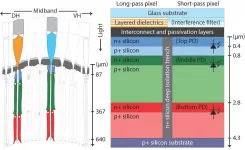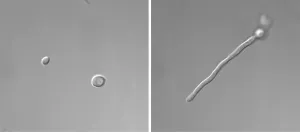INFORMATION:
Mantis shrimp eyes inspire six-color imaging platform for cancer surgery
2021-05-05
(Press-News.org) Inspired by the powerful eyes of the mantis shrimp, scientists have designed an imaging system that can distinguish between cancerous and healthy tissues during cancer surgery. The system accurately labeled tumors in mice and visualized lymph nodes near tumors in 18 patients undergoing surgery for breast cancer. With further development, the camera could help surgeons remove the marginal tumor tissues that can remain after unguided surgery, potentially lowering the risk of cancer relapse. It is critical for surgeons to remove as much tumor tissue as possible during surgery, but anywhere from 25% to 40% of patients still undergo incomplete tumor surgery for malignancies such as head and neck cancer. Digital cameras can help highlight cancerous tissue when combined with fluorescent molecules, but previous fluorescent imaging systems have not been widely adopted. Steven Blair and colleagues blended technology and nature in a fluorescent platform inspired by the mantis shrimp, a marine crustacean with highly complex eyes that provide information at a density unmatched by any human-made spectral camera. To mimic the mantis shrimp eye, Blair et al. vertically stacked layers of silicon photodetectors and spectral filters into a single-chip system platform, which can detect multiple colors and near-infrared light through 6 channels. The sensor successfully detected two fluorescent molecules in human prostate tumors in mice and distinguished cancerous tissue from healthy tissue in 92% of cases. The team also used their camera in the operating room to visualize 18 patients with breast cancer, where it allowed surgeons to accurately map out lymph nodes close to tumors. The researchers note their system's compact nature and low weight allow it to be integrated seamlessly into the operating room without slowing down a surgeon's workflow.
ELSE PRESS RELEASES FROM THIS DATE:
Can an AI algorithm mitigate racial economic inequality? Only if more black hosts adopt it
2021-05-05
Machine learning algorithms can leverage vast amounts of consumer data, allowing automation of business decisions such as pricing, product offerings, and promotions. Airbnb, an online marketplace for vacation rentals and other lodging, created an algorithm-based smart-pricing tool that is free to all Airbnb hosts and allows hosts to set their properties' daily price automatically. A new study investigated the impact of Airbnb's algorithm on racial disparities among Airbnb hosts. Adopting the tool narrowed the revenue gap between White and Black ...
New, almost non-destructive archaeogenetic sampling method developed
2021-05-05
An Austrian-American research team (University of Vienna, Department Evolutionary Anthropology and Harvard Medical School, Department of Genetics), in collaboration of Hungarian experts from Eötvös Loránd University, has developed a new method that allows the almost non-destructive extraction of genetic material from archaeological human remains. The method allows anthropologists, archaeologists and archaeogeneticists to avoid the risk of serious damage to artefacts of significant scientific and heritage value, which can then be fully examined in future research.
Bioarcheological ...
Depression part of daily life for many Black Canadians
2021-05-05
The first mental health study of Black communities in Canada has found the majority of Black Canadians display severe depressive symptoms - women, even more so - with racial discrimination confirming the appearance of these signs for nearly all.
The study, published in Depression and Anxiety, discovered nearly two-thirds (65.87 percent) of surveyed participants reported severe depressive symptoms. Higher rates were found among women; those who are employed; those born in Canada; and nearly all who have been experienced high racial discrimination.
"Rates of depressive symptoms among Black individuals are nearly six times the 12-month prevalence reported for the general population in Canada," says ...
Rapid rovers, speedy sands: fast-tracking terrain interaction modeling
2021-05-05
Granular materials, such as sand and gravel, are an interesting class of materials. They can display solid, liquid, and gas-like properties, depending on the scenario. But things can get complicated in cases of high-speed vehicle locomotion, which cause these materials to enter a "triple-phase" nature, acting like all three fundamental phases of matter at the same time.
As reported in the April 23, 2021 issue of the journal Science Advances, a team of engineers and physicists from the Massachusetts Institute of Technology (MIT) and Georgia Institute ...
Supersymmetry-inspired microlaser arrays pave way for powering chip-sized optical systems
2021-05-05
The field of photonics aims to transform all manner of electronic devices by storing and transmitting information in the form of light, rather than electricity. Beyond light's raw speed, the way that information can be layered in its various physical properties makes devices like photonic computers and communication systems tantalizing prospects.
Before such devices can go from theory to reality, however, engineers must find ways of making their light sources -- lasers -- smaller, stronger and more stable. Robots and autonomous vehicles that use LiDAR for optical sensing and ranging, manufacturing and material ...
Dark matter detection
2021-05-05
Scientists are certain that dark matter exists. Yet, after more than 50 years of searching, they still have no direct evidence for the mysterious substance.
University of Delaware's Swati Singh is among a small group of researchers across the dark matter community that have begun to wonder if they are looking for the right type of dark matter.
"What if dark matter is much lighter than what traditional particle physics experiments are looking for?" said Singh, an assistant professor of electrical and computer engineering at UD.
Now, Singh, Jack Manley, a UD doctoral student, and collaborators at ...
From yeast to hypha: How Candida albicans makes the switch
2021-05-05
BUFFALO, N.Y. -- You might call Candida albicans a shape-shifter: As this fungus grows, it can multiply as single, oval-shaped cells called yeast or propagate in an elongated form called hypha, consisting of thread-like filaments.
This dual nature can help the pathogen survive in the body, where it can cause disease, including dangerous hospital-acquired infections.
But how does this switching ability occur?
New research identifies one factor that may contribute. In a study that will be published on May 5 in the journal mSphere, University at Buffalo biologists Guolei Zhao and Laura Rusche report that a protein called Sir2 may facilitate C. albicans' transition from ovoid yeast ...
New ultrasound technique detects fetal circulation problems in placenta
2021-05-05
WHAT:
A team of researchers funded by the National Institutes of Health has developed a new ultrasound technique to monitor the placenta for impaired fetal blood flow early in pregnancy. The technique, which uses conventional ultrasound equipment, relies on subtle differences in the pulsation of fetal blood through the arteries at the fetal and placental ends of the umbilical cord, potentially enabling physicians to identify placental abnormalities that impair fetal blood flow and, if necessary, deliver the fetus early. Like current ultrasound techniques, the new technique can also detect impaired flow of maternal blood through the placenta.
The study was conducted by John G. Sled, Ph.D., of The Hospital for Sick Children in Toronto, ...
New imaging technique captures how brain moves in stunning detail, holds diagnostic potential
2021-05-05
Magnetic Resonance Imaging (MRI) images are usually meant to be static. But now, researchers from Mātai Medical Research Institute (Mātai), Stevens Institute of Technology, Stanford University, the University of Auckland and other institutions, report on an imaging technique that captures the brain in motion in real time, in 3D and in stunning detail, providing a potential diagnostic tool for detecting difficult-to-spot conditions such as obstructive brain disorders and aneurysms - before they become life threatening.
The new technique, called 3D amplified ...
How a Yale scientist and REM star named an ant for a Warhol 'Superstar'
2021-05-05
The ant came in a small vial of ethanol, sealed in a plastic bag, and packed in a small cardboard box. It was addressed to Yale's Douglas B. Booher.
German entomologist Phillip Hoenle had discovered the ant, which he noted had some peculiar features, in a rain forest in Ecuador. Now he wanted Booher, a research associate in the Yale Center for Biodiversity and Global Change and the Department of Ecology & Evolutionary Biology, to confirm whether this trap ant was truly a new species. If so, Hoenle and Booher would have the honor of naming it.
Booher had imagined ...






